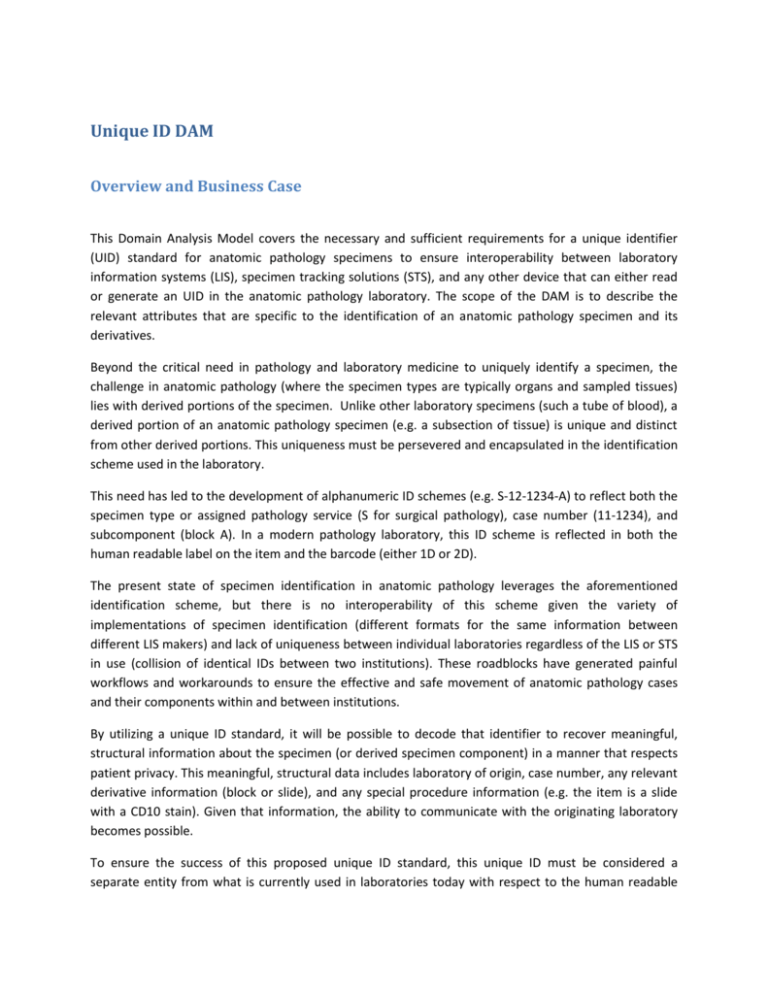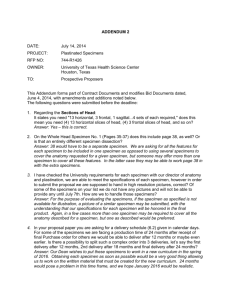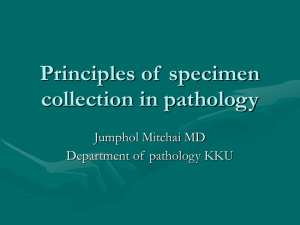Unique ID DAM
advertisement

Unique ID DAM Overview and Business Case This Domain Analysis Model covers the necessary and sufficient requirements for a unique identifier (UID) standard for anatomic pathology specimens to ensure interoperability between laboratory information systems (LIS), specimen tracking solutions (STS), and any other device that can either read or generate an UID in the anatomic pathology laboratory. The scope of the DAM is to describe the relevant attributes that are specific to the identification of an anatomic pathology specimen and its derivatives. Beyond the critical need in pathology and laboratory medicine to uniquely identify a specimen, the challenge in anatomic pathology (where the specimen types are typically organs and sampled tissues) lies with derived portions of the specimen. Unlike other laboratory specimens (such a tube of blood), a derived portion of an anatomic pathology specimen (e.g. a subsection of tissue) is unique and distinct from other derived portions. This uniqueness must be persevered and encapsulated in the identification scheme used in the laboratory. This need has led to the development of alphanumeric ID schemes (e.g. S-12-1234-A) to reflect both the specimen type or assigned pathology service (S for surgical pathology), case number (11-1234), and subcomponent (block A). In a modern pathology laboratory, this ID scheme is reflected in both the human readable label on the item and the barcode (either 1D or 2D). The present state of specimen identification in anatomic pathology leverages the aforementioned identification scheme, but there is no interoperability of this scheme given the variety of implementations of specimen identification (different formats for the same information between different LIS makers) and lack of uniqueness between individual laboratories regardless of the LIS or STS in use (collision of identical IDs between two institutions). These roadblocks have generated painful workflows and workarounds to ensure the effective and safe movement of anatomic pathology cases and their components within and between institutions. By utilizing a unique ID standard, it will be possible to decode that identifier to recover meaningful, structural information about the specimen (or derived specimen component) in a manner that respects patient privacy. This meaningful, structural data includes laboratory of origin, case number, any relevant derivative information (block or slide), and any special procedure information (e.g. the item is a slide with a CD10 stain). Given that information, the ability to communicate with the originating laboratory becomes possible. To ensure the success of this proposed unique ID standard, this unique ID must be considered a separate entity from what is currently used in laboratories today with respect to the human readable identifier in place now. Two reasons drive this separation. First, the physical space requirements present with some of the derived specimen types in anatomic pathology restrict the amount of information that can be present in the human readable part of the label. This is clearly seen in the labeling done for cassettes and slides, where the available area for a label is small given the size of the item. Another reason for the clear separation is the potential length of the unique ID so that the laboratory subidentifier can be long enough to handle the current and future number of laboratories globally. Unique ID Technical Schema Information Requirements Location ID – This is the origin of the specimen, such as the laboratory where it was accessioned. Case ID– The alphanumeric sequence that uniquely identifies the case for the given location. Part ID – The alphanumeric string that identifies the part of the case Block ID – The alphanumeric string that identifies the block of the case Slide ID – The alphanumeric string that identifies the block of the case Process ID – The ID corresponding to a process performed on the item Physical Requirements 2D Barcodes RFID tags Unique ID Use Case(s) Intralab This scenario involves two types of actor: the generator of the unique ID (UID) and consumers of the unique ID. For ease, these two groups will be referred to as “generators” and “consumers” going forward. The generator is the entity (typically an LIS) that generates the UID for the specimen or (specimen derivative). A consumer is a separate entity from a technology perspective (such as a different vendor) in the laboratory that interrogates the UID for specimen or specimen derivative identification for follow-on work, such as matching an order with patient material or querying the generating system for additional information on the specimen component. For this use case, the generator must be able to produce a standard UID that the consumer can interrogate and retrieve the correct identifiers (referenced above in the Information Requirements) for the component in hand. Given the location of the generator and consumer at the same institution, the location ID may not have immediate utility in the retrieval of additional information from the generating system due the existence of a direct interface between the consumer and the generator. Interlab This scenario is similar to the prior “Intralab” use case, only the generator and consumer(s) are located at separate laboratories. In this case, the generator produces the UID s for all components of the case, and the case is sent to another laboratory for further work. The consumers in this other lab must be able to interrogate the UIDs on the case and retrieve the information. The location ID is critical for this use case in that the consumer may need to query the generator via some trusted means of communication, and the location ID is the initial point of direction for the consumer to find the location of the generator. Implementation Issues/Scenarios 1. Space constraints on Unique IDs in the field 2. Deployment and maintenance of Unique ID repository a. Locally hosted b. Remote hosted with service 3. Trusted connectivity between labs for case information exchange Glossary Specimen – From DICOM Supplement 122 A physical object (or a collection of objects) is a specimen when the laboratory considers it a single discrete, uniquely identified unit that is the subject of one or more steps in the laboratory (diagnostic) workflow. Specimens are sampled and processed during a laboratory’s (diagnostic) workflow. Sampling can create new (child) specimens. These child specimens are full specimens in their own right (they have unique identifiers and are direct subjects in one or more steps in the laboratory’s (diagnostic) workflow. This property of specimens (that can be created from existing specimens by sampling) extends a common definition of specimen which limits the word to the original object received for examination (e.g., from surgery).







